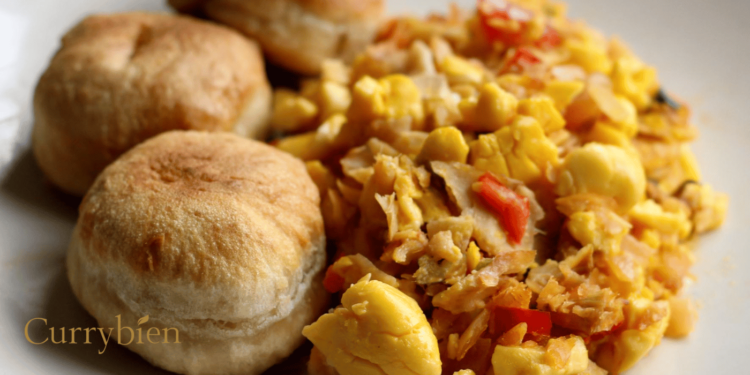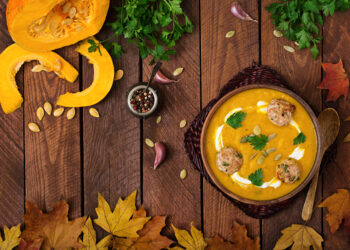Jamaican cuisine is a vibrant reflection of the island’s rich history, blending influences from Indigenous peoples, African slaves, Indian indentured servants, Spanish colonizers, and British settlers. Known for its bold flavors, spicy seasonings, and tropical ingredients, Jamaican food is a celebration of diversity and cultural fusion. Staples like rice and peas, jerk chicken, patties, and curry goat have gained international acclaim for their distinctive tastes.
Introduction to Akee and Saltfish as a Quintessential Jamaican Breakfast Dish
Among the plethora of mouthwatering dishes that make up Jamaican cuisine, Akee and Saltfish stands out as a beloved breakfast classic. This iconic dish perfectly encapsulates the essence of Jamaica’s culinary traditions with its unique blend of flavors and textures. Akee fruit symbolizes Jamaica’s tropical bounty while salted cod speaks to the island’s historical ties with the sea.
Together, they create a harmonious culinary union that has been cherished by generations of Jamaicans as a comforting and hearty way to start the day. The significance of Akee and Saltfish extends beyond its delicious taste; it embodies the spirit of Jamaica’s culture and heritage on a plate.
Origins of Salted Cod in Jamaica
Salted cod, commonly known as saltfish, has a rich history in Jamaica dating back to the colonial era. The practice of salting and preserving fish was introduced by European colonizers who brought this method to the Caribbean to ensure a stable food supply for long sea voyages.
Salted cod became a staple in Jamaican cuisine due to its ability to be stored for extended periods without refrigeration. This preservation method not only prolonged the shelf life of the fish but also intensified its flavor, making it a versatile ingredient in various dishes.
Akee Fruit to Jamaica from West Africa
The akee fruit, scientifically known as Blighia sapida, found its way to Jamaica through the transatlantic slave trade from West Africa. Believed to have originated in Ghana and Ivory Coast, akee was brought to the Caribbean by enslaved Africans who incorporated it into their diets.
The fruit thrived in Jamaica’s tropical climate and soon became an integral part of traditional Jamaican cuisine. Akee is known for its unique appearance with bright red pods that burst open when ripe, revealing shiny black seeds surrounded by fleshy yellow arils.
Evolution of the Dish Over Time
The fusion of salted cod with akee fruit gave rise to one of Jamaica’s most iconic dishes: Akee and Saltfish. Over time, this dish evolved from humble origins into a beloved national treasure that symbolizes the island’s cultural heritage.
Initially considered peasant food due to its simple ingredients, Akee and Saltfish eventually gained popularity among all social classes in Jamaica and beyond. Its evolution reflects not only changes in culinary tastes but also highlights the resilience and ingenuity of Jamaican cooks who transformed basic ingredients into a flavorful masterpiece enjoyed by many.

Ingredients Used in Akee and Saltfish
Salted Cod (Saltfish)
Salted cod, commonly referred to as “saltfish” in Jamaican cuisine, is a staple ingredient in Akee and Saltfish. The process of salting and rehydrating cod fish involves preserving the fish with salt to extend its shelf life. To prepare salted cod for cooking, it is essential to soak the fish in water for an extended period to remove excess saltiness.
This step ensures that the final dish achieves a balanced flavor profile without being overly salty. The use of salted cod brings a unique umami depth to the dish, complementing the subtle sweetness of the akee fruit.
Akee Fruit
The akee fruit, also known as “ackee,” is an iconic ingredient that defines Jamaican cuisine. This pear-shaped fruit has a vibrant red exterior that opens up to reveal three large black seeds surrounded by soft, creamy flesh.
When ripe and properly prepared, the arils of the akee fruit have a buttery texture and nutty flavor reminiscent of scrambled eggs. However, it is crucial to note that improper handling or consumption of unripe akees can lead to toxicity due to hypoglycin A content.
To safely enjoy this tropical delicacy, it must be harvested when fully ripe and opened only after thorough cooking to eliminate any potential risks. Incorporating these two key ingredients—salted cod and akee fruit—into Akee and Saltfish not only highlights the rich flavors of Jamaica but also showcases the culinary ingenuity born from historical influences and local traditions.
Unlocking Flavor: Preparation Method for Akee and Saltfish
Soaking and Boiling Salted Cod to Remove Excess Salt
To begin the culinary journey of creating the delectable Akee and Saltfish dish, one must first attend to the salted cod. The salted cod should be soaked in cold water for at least 8-24 hours, changing the water every few hours to remove excess salt.
This essential step ensures that the fish is not overwhelmingly salty when incorporated into the final dish. Once adequately soaked, the cod should be boiled until tender, a process that further helps to mellow out its salty edge while maintaining its flaky texture.
Culinary Symphony: Cooking Techniques for a Flavorful Akee and Saltfish Dish
The artistry of preparing Akee and Saltfish lies in the harmonious blend of flavors achieved through precise cooking techniques. After soaking and boiling the salted cod, it is time to orchestrate a medley of ingredients in harmony.
Sautéing a marriage of onions, tomatoes, peppers, and aromatic spices like thyme and scotch bonnet pepper forms the flavorful base of this iconic Jamaican dish. The sizzling dance of these ingredients in a hot pan releases tantalizing aromas that set the stage for what is to come.
The Melding Moment: Adding Boiled Akees at the Right Moment
As any maestro knows, timing is crucial when bringing together different elements into a symphony of flavors. In crafting Akee and Saltfish, one must wait for just the right moment before introducing boiled akees into the mix.
The delicate texture of boiled akees can easily turn mushy if added too soon or too late in the cooking process. Waiting until the sautéed vegetables are perfectly softened and infused with spices ensures that when the akees are gently folded in, they retain their distinct shape and contribute their unique creamy texture to this beloved Jamaican breakfast classic.
Taste Profile: A Symphony of Flavors
Akee and Saltfish, the beloved Jamaican breakfast staple, offers a symphony of flavors that dance on the taste buds. The salty tang of the rehydrated salted cod perfectly complements the subtle sweetness of the akee fruit.
When sautéed with aromatic onions, tomatoes, bell peppers, and a medley of spices like thyme and Scotch bonnet peppers, this dish creates a harmonious blend of savory, mildly sweet, and spicy notes. The creamy texture of the akee pods adds a luxurious mouthfeel to each bite, while the tender flakes of salted fish infuse every mouthful with umami richness.
Nutritional Benefits: A Powerhouse Combination
Beyond its delightful taste profile, Akee and Saltfish also boast impressive nutritional benefits derived from combining akee fruit with salted fish. Akee fruit is a good source of essential nutrients such as vitamin C, potassium, fiber, and healthy fats. Paired with protein-packed salted cod fish rich in omega-3 fatty acids and lean protein, this dish offers a balanced mix of macronutrients necessary for overall health.
The combination provides sustained energy levels throughout the day while supporting heart health and cognitive function. Additionally, akee fruit contains antioxidants that help boost immunity and promote overall well-being.
Variations on the Classic Dish
Regional Differences within Jamaica
In Jamaica, the preparation of Akee and Saltfish can vary significantly based on regional influences. In the southern regions, such as Clarendon and Manchester, you may find a more robust use of Scotch bonnet peppers, adding a fiery kick to the dish. In contrast, in the northern parishes like St. Ann and Trelawny, there is a preference for milder flavors with a focus on fresh herbs like thyme and parsley.
Coastal areas often incorporate seafood elements like shrimp or lobster to elevate the richness of the dish. These regional variations highlight the diverse culinary landscape within Jamaica.
Modern Twists on Traditional Recipes
With globalization shaping culinary trends, modern chefs and home cooks are putting innovative twists on the traditional Akee and Saltfish recipe. One popular adaptation involves substituting traditional salted cod with smoked salmon for a lighter yet equally flavorful version of the dish.
Vegetarian renditions replace salted fish with plant-based alternatives like ackee mushrooms or marinated tofu to cater to dietary preferences without compromising taste. Some chefs experiment with fusion flavors by infusing Asian spices or Caribbean-inspired sauces to create a fusion masterpiece that pays homage to tradition while embracing contemporary gastronomic influences.
Cultural Significance
The Heartbeat of Jamaican Cuisine
Akee and Saltfish hold a revered place in Jamaican culture, symbolizing the country’s complex history and rich culinary heritage. As the national dish of Jamaica, this savory breakfast represents the fusion of African, European, and Caribbean influences that define the island’s identity.
Beyond mere sustenance, akee and saltfish are a source of national pride, showcasing Jamaica’s resilience and creativity in transforming humble ingredients into a culinary masterpiece. The dish transcends its gastronomic appeal to embody the spirit of unity and community that characterizes Jamaican society.
Traditional Occasions and Ceremonial Feasts
Akee & Saltfish: Celebrating Life’s Milestones
In Jamaican culture, akee and saltfish are more than just a breakfast staple; they play an integral role in traditional occasions and ceremonial feasts. From birthdays to weddings, funerals to holidays, this beloved dish graces the tables at important milestones in Jamaican life.
The warmth of family gatherings is enhanced by the aroma of sautéed onions mingling with delicate akees and flaky saltfish. It is believed that sharing a meal of akee and saltfish symbolizes unity, prosperity, and good fortune for those partaking in these communal feasts.
Thus, every bite becomes a celebration of life’s blessings amidst loved ones. This section delves into how Akee & Saltfish is deeply intertwined with Jamaican customs as it encapsulates not only flavors but also emotions tied to tradition.
Popularity Beyond Jamaica
International Recognition as a Signature Jamaican Dish
Akee and Saltfish have transcended their Jamaican roots to gain international acclaim as a beloved and iconic dish that represents the vibrant flavors of Caribbean cuisine. This flavorful combination of salted cod and akee fruit has captured the hearts and palates of food enthusiasts around the globe.
Chefs and food bloggers from different countries have embraced this dish, showcasing its rich history, complex flavors, and cultural significance. Akee and Saltfish have become synonymous with Jamaica’s culinary identity, proudly flying the flag of Jamaican gastronomy on the global stage.
Conclusion
In a world where culinary traditions often blur boundaries and bring people together through shared experiences at the table, Akee and Saltfish stand as shining examples of how food can transcend borders to unite us in appreciation for diverse flavors and cultures. As we savor each bite of this quintessential Jamaican breakfast, let us remember not only the culinary artistry behind it but also the stories woven into every ingredient that make it a truly remarkable dish.
Let Akee and Saltfish serve as a reminder that diversity is not just about what we eat but also how we celebrate our unique heritage through food. So, embrace new tastes, cherish old traditions, and always keep an open mind – for in every recipe lies a story waiting to be shared with the world.


















